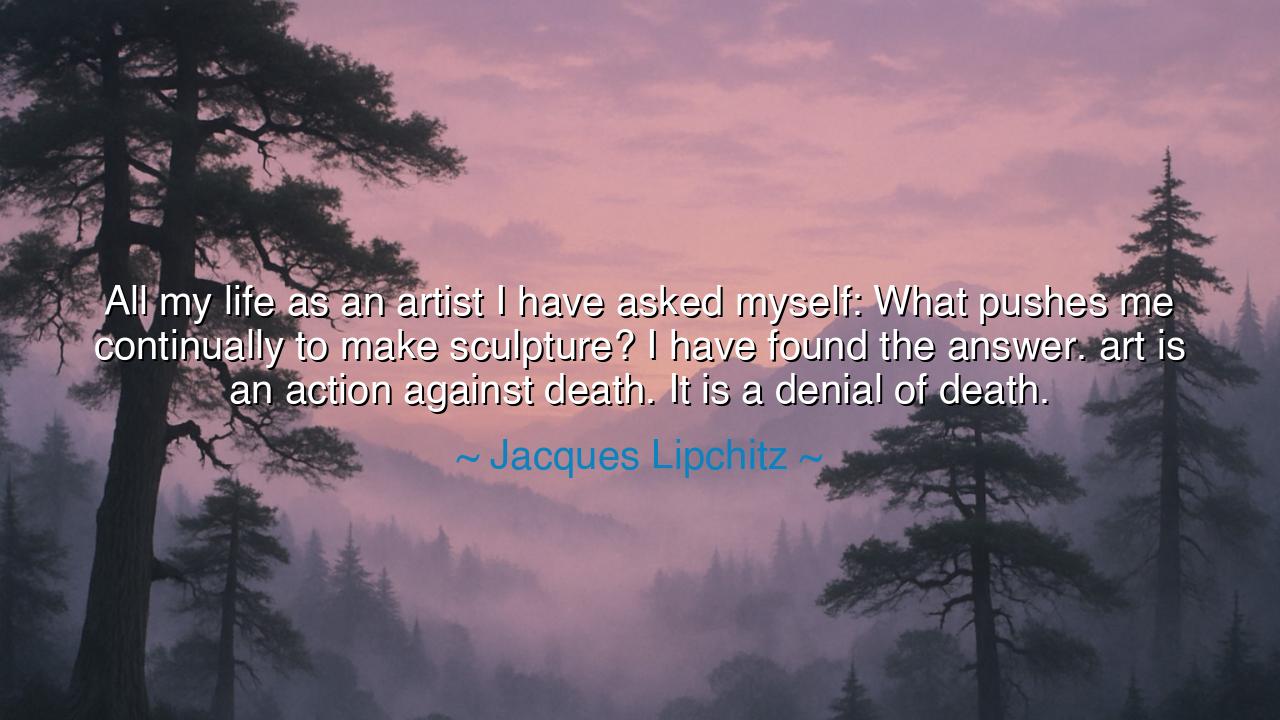
All my life as an artist I have asked myself: What pushes me
All my life as an artist I have asked myself: What pushes me continually to make sculpture? I have found the answer. art is an action against death. It is a denial of death.






The sculptor Jacques Lipchitz, who shaped form from the silence of stone, once declared with timeless conviction: “All my life as an artist I have asked myself: What pushes me continually to make sculpture? I have found the answer. Art is an action against death. It is a denial of death.” In these words lies the sacred heartbeat of all creation — the eternal human defiance of oblivion. To create is to stand before the endless night and cry out, “I will not be forgotten.” Lipchitz understood that art is not merely craft, but rebellion — a heroic resistance against the decay of time, a flame lit in the wind, daring to burn even as the darkness deepens.
From the dawn of civilization, mankind has waged a silent war against death — not with swords, but with symbols. The caves of Lascaux, painted with ochre hands and galloping beasts, are the first cries of the human soul saying, I was here. The pyramids of Egypt, the epics of Homer, the statues of Greece — all are monuments not only to gods or kings, but to the unyielding desire to outlast the grave. Jacques Lipchitz, born into a century of fire and exile, carried that same ancient longing. As wars ravaged his homeland and worlds collapsed, he turned again and again to sculpture — to the act of shaping permanence from fragility. In his hands, clay became defiance; bronze, a testament.
When he says “art is an action against death,” Lipchitz does not speak of physical immortality. He speaks of the soul’s refusal to vanish. Every stroke of the chisel, every curve of his figures, was a conversation with eternity. Death silences; art speaks back. Death erases; art remembers. In the act of creation, time itself bends, and a fragment of the human spirit is preserved. The artist, like the ancient warrior, faces the inevitable — but instead of surrender, he offers beauty. In this way, art becomes a prayer made solid, an offering against nothingness.
Consider the life of Michelangelo, who, in the damp halls of Florence, wrestled with marble as if contending with fate itself. When asked why he carved so fiercely, he replied that the figure was already inside the stone — he merely set it free. His David, his Pietà, his Moses — all stand centuries later, breathing with life though the hand that made them has long turned to dust. This is the victory of the artist: to create something that lives when he no longer does. Michelangelo’s hammer was not merely a tool of art, but a weapon against oblivion, echoing Lipchitz’s truth — that to make art is to deny death its final word.
The origin of Lipchitz’s revelation lies in his life as a man who endured exile, loss, and war. A Jewish sculptor who fled Nazi-occupied Europe, he saw with his own eyes the fragility of existence — how swiftly nations fall and how easily names vanish. In the face of such horror, many would have despaired. But Lipchitz chose the path of creation over destruction. Each sculpture he made was a statement of survival, a proclamation that beauty can rise from ashes. His art was not an escape from death — it was a direct confrontation with it.
His words carry a message not only for artists, but for all who live with awareness of life’s brevity. Every act of love, every gesture of kindness, every word spoken in truth — these too are forms of art, small denials of death. For death claims only what is forgotten; what is remembered lives on. When you build, when you nurture, when you speak with sincerity, you participate in this same sacred rebellion. You carve your existence into the fabric of time.
So let this be the lesson, passed down like fire from one generation to the next: Create, and you will conquer silence. Love, and you will outlast decay. Live fully, and you will deny death its dominion. Whether with stone or song, with kindness or courage, shape something that endures. For every time a human being lifts their hands to make beauty, to tell truth, or to heal — death trembles, if only for a moment.
Thus, as Jacques Lipchitz reminds us, the artist is not merely a maker of form, but a guardian of memory, a servant of eternity. His hands declare what every heart longs to believe: that though flesh may fall, the spirit that dares to create will never truly die. In the end, art is the flame that outlasts the funeral pyre — and as long as one human soul continues to shape, to dream, to love, death is forever denied its final victory.






AAdministratorAdministrator
Welcome, honored guests. Please leave a comment, we will respond soon